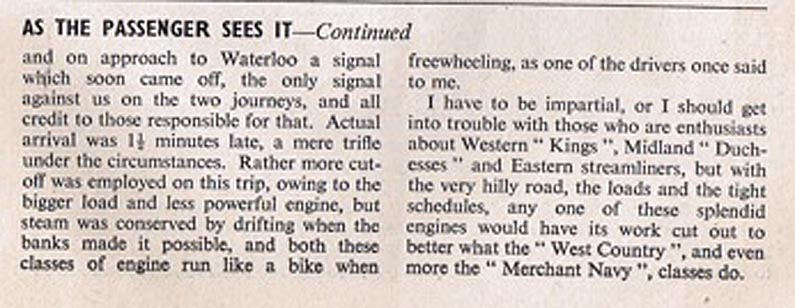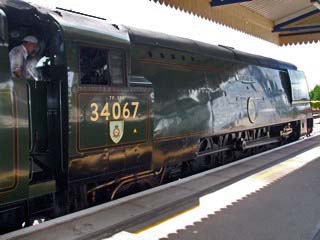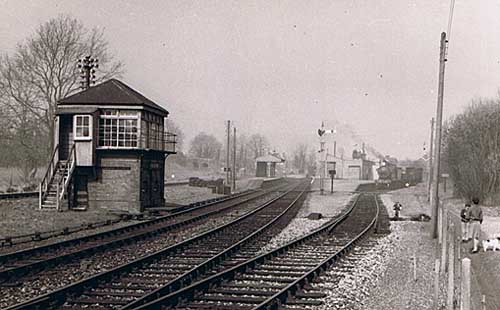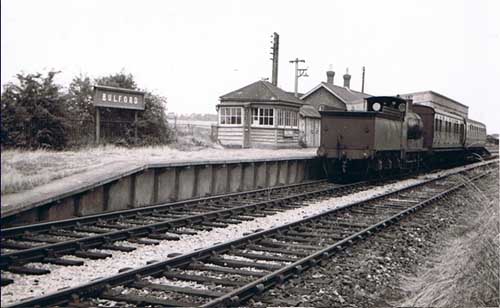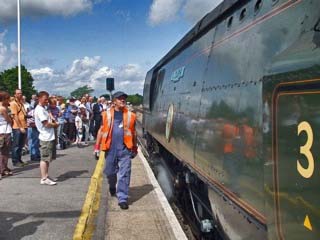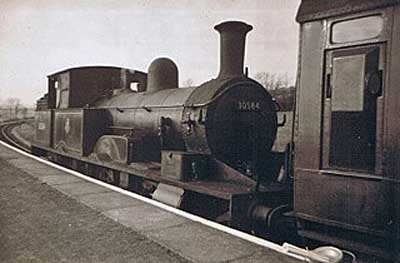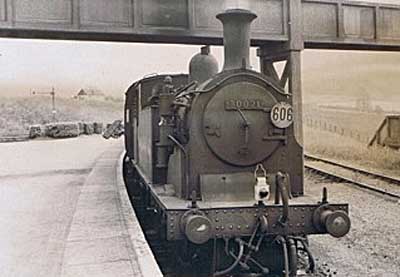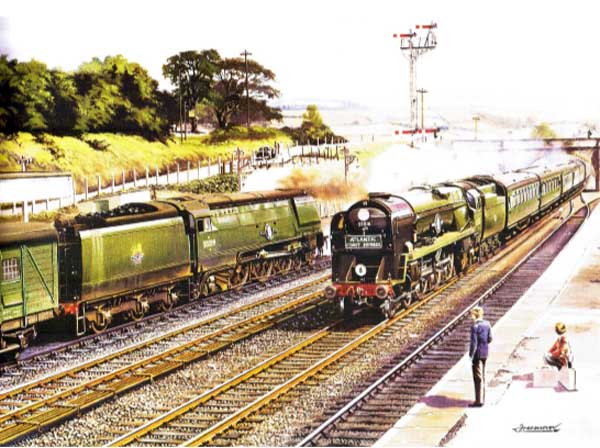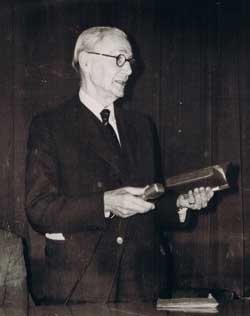
MAINLINE STEAM REFLECTIONSINTRODUCTIONHere are three reflections for you to appreciate this winter. Subscribers to the Nine Elms website LES PITCHELL and PETER STEWARD bring to your attention something personal from their own 1950's footplate experiences. More up-to-date I recount more recent memories in - 'WESTWARD HO!' - a footplate view of the route to Exeter. I do hope that you find the following articles of interest, particularly the two 1950's footplate memories some fifty odd years later, all in the company of some of the finest past iconic Southern Enginemen! JAMES (JIM) LESTER -70A
AS THE PASSENGER SEES ITAS THE PASSENGER SEES IT, by E. S. WATERHOUSE was a regular feature in ASLE&F's publication - The Locomotive Journal - back in the 1950's. The author wrote many similar observations of regional train journeys from the locomotive perspective however this one is of particular interest as it records the events that took place back in 1956 on the footplate of original 'Merchant Navy' class No. 35019 French Line CGT hauling the Southern's 'ATLANTIC COAST EXPRESS'.The crews working this prestigious train on the day were from Nine Elms depot, Driver TOM SMALDON and Fireman DEREK PITCHELL, whilst the onward crew from Salisbury comprised Driver BRITTON and Fireman FINNIS. Besides the descriptive journey timings and footplate details there is an interesting initial observation that the locomotive is unique amongst the class of thirty inasmuch that it had at that time a single blast-pipe fitted rather than the normal Bulleid multiple design. Indeed he might also have added that the shipping company nameplate was also unique having a script written name casting rather than the block lettering like all the others! The return journey is on another day, however we have a smaller Bulleid locomotive this time namely original 'West Country' class No. 34026 'Yes Tor' that appears to be good order as it needs to be on the up ACE’s demanding schedule. We are duly introduced to the Exmouth Junction depot crew of Driver CHARLIE LODGE and Fireman PHILLIPS. Remarkably Charlie had two other brothers at the depot, in the same link! An interesting start ensues from Exeter Central, albeit 5 minutes late, that sees the engine making a somewhat sluggish start, and p.w. restrictions certainly didn’t help at all, but the craft of the crew comes through and a net 8 minutes are regained overall - excellent work! Whilst the heavier working of a smaller locomotive was required both classes of locomotives run 'like a bike free wheeling' it was said! The relieving Nine Elms crew this time is Driver PERCY COX and his mate, our old friend LES PITCHELL, from whom we gratefully received this article. Now 4 minutes late, with the load actually increased, the challenge lay ahead. A fine description of the run follows on, finally ending back at Waterloo just 1min 30secs late having started the journey earlier in the day from Padstow, Ilfracombe and Plymouth!
AN EARLY RECORDED TRIP BEHIND A MODIFIED MERCHANT NAVYAt the same time I was putting together these footplate articles I was contacted by a former Nine Elms colleague and old friend, Peter Steward. He told me that he had recently found an interesting log of a mainline trip, made back in July 1957, that had been sent to him by a Mr. C. K. DUNKLEY, so I'm more than pleased to be able to include it here! On the actual day, prior to departure from Waterloo, he recalls that this gentleman introduced himself at the cab and politely informed both Peter and his driver that he would be timing their run throughout. As promised Peter later received in the post a covering letter and the log of the trip that until now had been 'hidden' away! The trip itself was down with 10h30 Bournemouth, a regular Nine Elms - Top Link - duty.The diagrammed locomotive for this duty was one of the depot's allocated Merchant Navy class, No. 35020 'Bibby Line', interestingly at that time the locomotive had not been rebuilt very long, being only the second one completed back in 1956! Driver FRANK BURRIDGE was the fine Engineman in charge as Peter's regular mate, WALLY HOOPER, was not available on the day. Quite a fascinating run with 12 coaches (a gross load of 450 tons), Peter recalled, with the locomotive being in absolute tip-top condition! Checkout the detailed log and appreciate the rather nice letter that was also received, how times have changed!
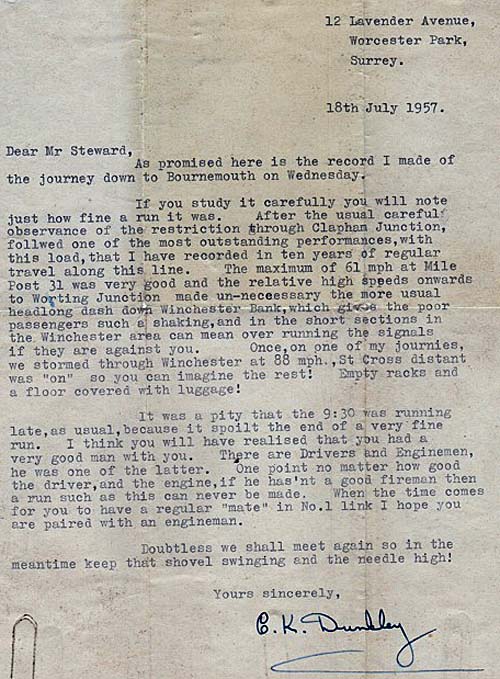 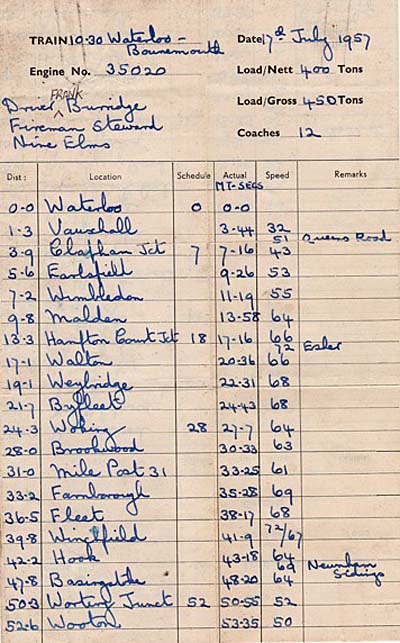 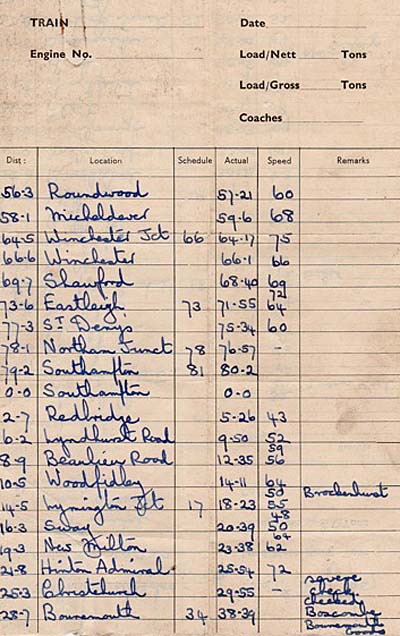 WESTWARD HO! IN RETROSPECT is my own account of a changing railway observed from the footplate of a familiar locomotive. ‘Battle of Britain’ class No. 34067 ‘Tangmere’. The line down to Salisbury, minus a few stations and semaphore signals now, seemed much the same to me as it ever was really. However beyond Salisbury was an education in terms of the severity of the cuts that took place after the regional changes in the mid 1960’s. Recent years have seen a reversal of those earlier days with the line recovering from those vindictive actions at that time. Double track once more back where it rightfully belongs and a thriving service using it! On my journey I managed to find all the old stations, now sadly closed, that I remember the Salisbury station announcer would provide for the traveller to such far flung locations in Dorset, Somerset and Devon, then on even further, Cornwall.
'Westward Ho!' in retrospectby James (Jim) Lester (Southern Region Engineman)
On Sunday the 5th July 2009 I made my way to my local station at Woking and arrived at 08h45. The purpose of my mission was to possibly turn the clock back to the early-sixties and experience once again mainline steam down the Exeter road, this time back on the 'footplate'. What actually occurred when I joined the footplate and the crew of Class 'Battle of Britain' No. 34067 'Tangmere' hauling 'The Cathderals Express' was beyond my expectations. Upon arrival of the train, just after 09h00, I initially met the locomotive's previous owner and now Operations Agent - John Bunch and due thanks were expressed for permitting this pre-arranged trip down to Salisbury. The driver on the day was my old Nine Elms colleague and longtime friend Peter Roberts. A brief exchange with his fireman, John Gibbins, and another footplate guest was completed before we were soon signalled out on to the 'Down Through', followed shortly by the tip to depart from the guard and we were away. A steady, sure footed start soon saw the train clear of the points before the serious work commenced entering St John's cutting and the gradient ahead. Years before the 1906 introduction of the electro-pneumatic equipment, that worked both lower quadrant gantry signals and points on the line, two intermediate signal boxes lay between Woking and Brookwood, namely 'St Johns' and 'Hermitage', their location bases still discernible all these years later. Brookwood during such times was actually a former junction to both the Necropolis Railway that served the two internal North and South stations in the huge cemetery on the down side. Whilst on the up side there was another junction that not only went to Bisley, the home of the 'National Rifle Association', but also on to a substantial military railway establishment beyond at Deepcut. Our original Bulleid light pacific was responding well to the Nine Elms touch that Peter has professionally retained over many years. Indeed it was an absolute pleasure to listen to, and observe once again, the varying aspects of the locomotive's progress like the exhaust events in conjunction with the use of the regulator and cut-off position. Whilst at the same time the rather smokey coal on the tender was being deftly applied to the locomotive's fire through the Ajax door by Peter's fireman, certainly providing more than adequate pressure on occasions!
Beyond Pirbright Junction, with a load of 11 coaches behind this 1947 Brighton built 'Battle of Britain', train speed increased further after milepost 31 was passed. Remarkable to reflect that this locomotive was originally withdrawn from service in 1963 and was today handling the train with comparative ease, certainly a testimony to the long, dedicated restoration program and to all the stalwarts that were and still are involved. Standing on the tender plate observing the mainline footplate activity, I quietly reflected on the many occasions that I had experienced such times previously, whatever this really was as good as it comes! Through the narrow single bore 'tunnel' of the aqueduct carrying the Basingstoke canal above, immediately followed by former Sturt Lane Junction, where from the Local line it originally crossed all tracks round to the right to 'Frimley Junction' and on to Ascot. We continued over the Ash Vale single line and then what little is left of the old trailing junction that came off the Frimley line. Immediately yet another embankment is viewed on the Up side, one that linked the mainline with the Reading line below at Farnborough North, although I must say I never ever saw any tracks on this formation. Really into our stride now, Farnborough was passed with ever increasing speed, followed by the long gone Bramshot Halt and then on to Fleet. In the past this was where the compressed air was produced and stored for the line's electro-pneumatic operation. In later years serious consideration was given to the provision of water troughs in several locations, one of them being between Farnborough and Fleet. After in depth examination the scheme was eventually abandoned. Winchfield, then Hook were both soon in our wake! Then, when coming out of the deep cutting after Hook, we passed the remnants of the little siding at Newnham, always a location question that you were asked when discussing your route knowledge back at Nine Elms in the fifties and sixties! Incidentally at Hook the water tap on a Bulleid tender, located immediately behind the driver, was always tested here and was a good indicator to the amount of water that that you had left. Without water showing in the tap was not a good omen and an out of course water stop at Basingstoke was not completely unknown in certain circumstances, more so when working down the Salisbury road! We had no concerns about water, not today, as we thundered through Basingstoke at speed with green signals ahead, on up towards what were the old semaphore intermediate block signals at Winklebury that were followed by Worting Junction. In the process we passed what looked like the yard shunting neck on our left that in fact is the last remnant of the original track-bed of the line to Alton of Will Hay fame in the film 'Oh Mr. Porter'! At Battledown, originally a flat junction, we branched away right under the flyover now carrying the original London & Southampton Railway up line, and made our way west on the much later built L&SWR line. The small village of Oakley had earlier had a station, sadly now long gone since 1963, however an over-bridge still retained its white painted brickwork that aided observation of the semaphore 'Home' signal on its approach. Overton is next and the large works located there is seen in advance of the approach to the station. Situated on the up side, it was known as the 'Pound Note Factory' to many footplate crews due to its production of highly specialised paper and bank notes. On further to the former three platform station Whitchurch North, as it was called in the steam days due to there being two stations, the other one just down below the end of the platform in the valley on the left. This was on the former GWR line, originally known as the DNS (Didcot, Newbury & Southampton). A line built by that company quite late in 1891, purely intended to tap into the docks and the potential traffic to the Midlands and beyond. Now down through Hurstbourne and across the viaduct and the watercress beds that lie below, an area immortalized in Richard Adams' wonderful book 'Watership Down'. Not too many rabbits to be seen scampering away today!
Exaggerated rumour had it that certain Nine Elms drivers had actually 'set fire' to the same cress beds below such was the manner that they worked their locomotives would you believe! Climbing now, past the location of Hurstborne Junction that took trains to Long Parish, Wherewell and on to Fullerton Junction and the Test valley line. Onward up to the top of the bank, beyond which the area is known as Enham. During the three-mile 1 in 178 downward sweep in semaphore signal days the fireman would be looking for the 'Distant' signal for Andover Junction, essential to 'catch' this one early for the driver, as speed was usually quite high I recall. Indeed on the day we were doing very well ourselves and Peter reduced the steam chest pressure as our speed hovered 'around' 75mph. Clearly 'Tangmere' wanted to go faster, like many of its class mates had before, but sadly some restraint was necessary today! Never mind it was still a fantastic feeling as we approached the station at high speed and with a lingering blast on the whistle we went through the platform and were instantly climbing again, 1 in 220 up to 'Red Post Junction', where the old 'Midland & South Western Junction Railway' line branched away to our right on its original route to Cheltenham. Looking back I recall one morning working down with the 9.00am Waterloo - Salisbury - Exeter, when running into Andover Junction, that I observed a locomotive sticking out through the 'demolished' back wall of the small engine shed. I daresay her driver booked her requiring new brake blocks that day! With the immediate ascent of the bank up to Grateley the regulator position was again supplying the steam chest, valves and cylinders with ample pressure. Years earlier, beyond 'Red Post Junction's' signals there was a further intermediate block signal at Monxton that broke up the rather long climbing section. The almost seven mile ascent eventually eased at milepost 71.I when passing under a large girder bridge just west of Grateley.
A single line between Grateley, Amesbury and Bulford Camp was built in 1904 and ran parallel alongside the Up road for two and a quarter miles before finally disappearing into the distance over Salisbury Plain towards Stonehenge! Originally there was a triangular track layout that also allowed traffic from Salisbury direct access to the Amesbury branch. Such was the movement of military equipment in and out of the large army camp at Bulford that it actually warranted a flying junction to be built that was known as Amesbury Junction. Later when the line was eventually abandoned and the track lifted it was renamed Allington, and acted as an intermediate signal box. The 'top-secret' military research establishment on Porton Down is actually skirted by the railway line and Idmiston Halt, taking its name after a nearby village, was eventually built for the civilian employees. This was followed by Porton station, about a quarter of a mile away through the deep chalk cutting around the corner, both stopping points now long gone, withdrawn in 1968. We hastened through what little was left to observe of the original station, then on down through the Winterbournes, 1 in 169 on to a really fast bit of the line indeed. Another interesting 'rumour' had it that a certain driver on sighting a far distant red light in the dark one night attempted to stop at it, embarrassingly only to find out that is was actually the one located on the top of the 404ft high spire of the cathedral in the valley! During the drop down towards Tunnel Junction the finishing touches would have been made to the normally quite 'substantial' fire in a Bulleid pacific, particularly a Merchant Navy, especially for the relieving crew. Many of the rather dour senior Exmouth Junction firemen were in their late forties in those days, they certainly seemed to cheer up somewhat when they saw the huge fire rolling out of the fire-hole door! Today we were running quite early and with previous caution signals we steadily approached Tunnel Junction and stopped on the triangle of lines. Strange, but ironic in many ways was the installation of the Laverstock loop on what was just an embankment all those years ago. It was in fact part of the original 1857 built route from Basingstoke to Salisbury's Milford terminus, the city's very first station. The departure of a Portsmouth service finally cleared our path into Salisbury's platform four and as we entered the platform the crowd of people waiting for the train's arrival was quite a sight. My footplate trip was over all too soon as we arrived at Salisbury, where we had quite some 'dwell' time, and once stationary I went back with Peter to the support coach whilst some of the support team serviced the locomotive. It was when chatting with the rest of the team that John Bunch asked me if I'd like to continue through to Honiton, well what can you say to an offer like that? Previously I had never ridden on the footplate over this section of the line, indeed it had always been an ambition never achieved, and one that I truly believed was long, long gone! Many was the time that I had watched our relieving crew at Salisbury restarting our train from London bound for the West of England and had wondered just what it would be like to work over the route? Well I was about to find out all these years later and on rejoining the footplate I found John busily building up the fire for the journey ahead. Peter in the meantime made some last minute inquiries before returning to the cab where he then ensured all was well on the footplate before making ready for departure. In next to no time we were away and as we passed the sad remains of Salisbury's loco shed heading up to Wilton South, I must say that I was really looking forward with anticipation to the next 'train of events', indeed I wasn't disappointed!
It was evident Peter knew the route particularly well and 'Tangmere' was really put through her paces as we accelerated up the initial 1 in 115 gradient. Today's track layout is in stark contrast to that of yesteryear, single line sections with passing loops all controlled by colour light signals, as one would expect! Today both the former Southern Railway and Great Western Railway stations at Wilton are but a distant memory to those of us that can recall such times. Years earlier in 1947 Nine Elms Enginemen had learned the road through to Wilton South for the post war introduction of the 'Devon Belle', an all Pullman express with an Observation Car. The idea being that the locomotive change would not take place at Salisbury, but out of sight around the corner! Despite some dips in the profile of the line the gradient is, in the main, much against you until Semley where the summit is reached. However the dip at Wilton, mile post 85, certainly allowed 'Tangmere' to gain some extra speed as we passed Ditchampton School, then crossed the River Wylie and continued along the Nadder Valley. Between Dinton and Semley the route is a series of successive curves and the few dips on the line between these points aided our progress. Tisbury, still an operational single platform station, was passed with a longer than usual use of the whistle as requested for someone's mum who lives nearby! As we neared the top of the climb to Semley we passed milepost 100, quite an ascent and once over the crest of the bank Peter took advantage to reset both the regulator and cut-off position on the initial falling gradient of 1 in 100 that continue for a good four miles until Gillingham. Interestingly I had been watching Peter's method in using the steam reverser, in a manner that many former Nine Elms men applied. Always there was a reduction in the steam chest pressure before attempting to 'notch up'. Having achieved the setting required the regulator equally was reset once again! Why? Well steam reversers sometimes have a mind of their own, indeed they could inexplicably drop into full forward gear or reverse on occasions. This simple reduction in steam chest pressure initially assisted the reverser's movement of the valves and in the event of a mishap saved the fire being lifted by a sudden blast and literally going up the chimney, it also reduced the shock of such an action and indeed averted the outside chance of a boiler surge causing priming. Needless to explain the dire consequences of an engine suddenly thrust into reverse with a large regulator opening! Another little point that Peter and I discussed was that many of the Enginemen that we fired to in the past carried a bit of chalk in their pockets and would mark the sector plate and pointer for ease of observation, in both day and night! Caution signals approaching Gillingham saw the train speed reduced accordingly and we eventually steadily ran into the Dorset station. During our fine run from Salisbury a red fault light was noted on the OTMR equipment, now carried on the footplate of all mainline steam locomotives. As such this was duly reported and was immediately investigated by John Bunch. One of the tender cupboards now houses the electronics that provide the power for the statutory Driver Monitoring/Recording device that can be downloaded in the event of an incident. John went through the whole system and when he was satisfied, reset and re-tested the OTMR successfully. He believed that a serious jolt 'en route' was the likely cause of the failure. Indeed no further problems were observed. The reasonable gradient at the initial start from Gillingham soon turns into something quite arduous and the climb 1 in 100 up to Buckhorn Weston tunnel (742 yards) and the summit just beyond is made all the much harder from a 'dead' stand. Compare this with fast trains that could attack the bottom of the incline at 80 mph plus and lose but 20 mph on the full ascent. Extreme care on the footplate is essential when entering tunnels. There is always the inherent danger of a blowback through an open fire hole door. When necessary drivers would indicate to their preoccupied fireman when a tunnel was being approached, particularly at night. Any attention to the fire would cease immediately and the fire door would be closed and the blower applied. The main cause of such an event is the close proximity between some tunnels roofs and the locomotive's chimney. This situation has been compounded over many years by the increased size in locomotive design, including boiler dimensions that have finally reached the maximum loading gauge limit. Then add to this the possibility of another train entering the tunnel at the same time, the combined effect literally further compressing the air in the confined space, this could be catastrophic if the previous precautions were not always rigidly applied. Another tunnel danger was that of slipping due to the damp interiors, in particular where the gradient is still against you and the regulator is still well open then the driver must be ready to react immediately at the first hint of a slip, indeed use of the steam sands before entry is a wise precaution. Once the train was clear of Buckhorn Weston tunnel at milepost 107.ll the top of the bank is attained and the gradient reverses, inasmuch that the immediate downgrade is now similarly 1 in 100 and speed soon picks up and by the time the bottom of the bank is reached at milepost 110, we were back well on the 70 mph plus mark! Then the gradient levels out for one mile, the respite is short though and immediately we are back against the collar again as the gradient seesaws back to 1 in 80 on the severe approach up to Templecombe. However our progress does not last for too long as a 'Distant' colour-light signal checks our speed in order to leave the single line section and join the double section after Templecombe station. A steady approach towards the 'Stop' signal sees the time delay operated signal clear to 'Green' in good time and steam was immediately re-applied to regain the lost momentum on the rising gradient. Time has not been too kind to many of the stations on this magnificent line, none more so than to Templecombe. This once vibrant little junction station was indeed unusual, certainly in the manner that it connected with the trains from Bath and Bournemouth that crossed beneath its path on the former Somerset & Dorset line. Little actually remains to remind those of us that spent perhaps too short a time, standing on its interchange platform, and who witnessed the unique passenger train shunting manoeuvres in this quiet rural corner of Somerset. Even its small engine shed, set on the edge of the rolling countryside, oddly hosted locomotives from the Midlands that normally would have been more at home in the peaks of Derbyshire. How could anyone ever forget a railway whose character was so very special? Its closure at the time dealt a massive blow to the local community, liken to many devastating coal mining pit closures during the eighties that I recall, so sad! Such melancholy thoughts were fleeting as we passed through Templecombe's sole existing platform, now joining the double track section, and continued tackling the now 'slightly' eased gradient 1 in 100 for the next two miles. Once clear of the summit the long disused Milborne Port station was passed which then heralded the commencement of a six-mile fast section of the line, down through the ancient town of Sherborne and beyond, quite a lengthy stretch of it being 1 in 80. Like the earlier approach to old Andover Junction, the Sherborne 'experience' was just as spectacular, the long blast on the whistle indicated that steam was back in the West of England and warned all 'God Fearing Men' of our fast approach, speed was yet again duly reigned in to meet the regulations! With the gradient in our favour we continued running at high speed for another two miles before we met the next adverse gradient profile change, nothing as extreme as previously encountered, this was a mere 1 in 250 for about a mile, then dropping down again we approached Yeovil Junction. The alignment of the original Salisbury & Yeovil Railway (S&YR) to its original terminus in Yeovil dating back to 1860 swings away to the right just before we pass over the former GWR line to Weymouth. The S&YR was eventually absorbed into the L&SWR in 1878 giving the latter company sole operating rights over the complete route to Exeter. Despite the decline in the fortunes of the line Yeovil Junction as a station has fared the best of them all considering the draconian cuts that took place. It still retains its historical railway ambience that is sadly lost in other locations. The original downside platforms now provide the headquarters for the South West Main Line Steam Centre that has maintain the station buildings and track, that also includes the original turntable. In my recent book 'Southern Region Engineman' I have devoted a section to the introduction in 1957 of R. E. L. Maunsell's Class 'V' ('Schools') on the route as far as Yeovil Junction, where they were turned and serviced before their return to Waterloo. Certainly they were not a particular class of the older Southern Railway passenger engines that were ever seen in the South West. However in August 1962 due to the failure of the Merchant Navy hauling the up 'Atlantic Coast Express, No. 30934 'St Lawrence', that was in the yard at the time, was initially called upon to work the complete 'ACE' forward to Salisbury after which it actually continued on to Waterloo. What an incredible event, I know I was the fireman on the footplate from Salisbury! As we made our way into Yeovil Junction's former up line platform the branch line from old Yeovil Town came in from our right. Previously this line was served by a regular service known locally as the 'The Bunk' and, like many other branch lines en route, motive power then being a Drummond 'M7' and a 'Push & Pull' set, sadly there is no service connection today, just the tracks.
The station stand time here provided an opportunity to take some photographs and the chance to observe the splendidly preserved original downside platform and the site of the former GWR station Clifton Maybank. The turntable and pit are located at the end of the platform and will actually today provide the servicing facilities that our locomotive will use later before it returns to London. Eventually an incoming service off of the single line clears the road ahead and allows us to proceed to Honiton our next scheduled stop. As such the route west continues much the same as we previously encountered from Salisbury. Actually at milepost 123 we are sitting at the bottom of the bank that will eventually take us up past old Sutton Bingham station to the summit at Kit Hill, the ruling gradient is 1 in 140/150 so there is an early determined effort by Peter to accelerate our train away, I must say the engine has been working exceedingly well throughout the journey and continues to do so! Once over the crest of the bank the line thereafter descends into yet another valley and associated river, this time the Parrett. Down now 1 in 120 where the speed is increased in order to meet the challenge of the next bank. During such times that permanent way repairs were necessary a temporary speed restriction of 20mph or less could have quite demanding effect on the footplate, particularly for the fireman, dependant that is on the prevailing gradient. The additional physical work that was generated by such events was quite substantial when the locomotive was further extended in order to attempt to claw back the lost time. Certainly the severity of banks in the West of England that I had witnessed would require substantial effort from the crews involved. Indeed from milepost 130.II the gradient of 1 in 80 is met that takes you up through Crewkerne until the summit is reached some three miles later at milepost 133.II. Back in April 1953, Merchant Navy, No. 35020 'Bibby Line' survived a catastrophic crank axle failure here that subsequently resulted in the complete class of thirty engines being withdrawn from service. The fact that no one was killed or even injured is absolutely incredible, almost unbelievable, when one considers the magnitude of the mechanical failure on the day. Interesting times thus ensued as locomotives were borrowed from other regions of British Railways to substitute for the loss of the Southern's premier express class of locomotive. On the ascent of the bank between the hills of Shave and Curriot yet another subterranean line feature is encountered that being Hewish Tunnel 209 yards this time. On then westward now plunging down into the Axe Valley where we systematically criss-crossed the River Axe on the thirteen odd mile descent towards Axminster itself, taking us in and out of the shires of both Dorset and Somerset finally crossing the Blackwater River before entering Devonshire the county of our ultimate destination, Exeter. Restraint was again the order of the day and the speed of our Bulleid steed was reigned in yet again. One day in 1959 I recall as a passenger having just returned from Lyme Regis witnessing the extremely fast approach and passing of the 'ACE' on Axminster station, only then could I imagine just what the footplate experience was like on that day. Well today matters were being put to rights and I eagerly awaited our own approach and passing through! Meanwhile we still had some ground to cover and we were now fast approaching old Chard Junction, equally now devoid of any signs of its former railway history, how times had changed for this interesting little station with its milk traffic and its earlier GWR link to Chard itself. Oddly in its day requiring the erstwhile traveller to seek the 'other' station for the onward journey to the town, located as it was adjacent to that which they had recently arrived. Such thoughts were again momentary as we continued the journey of retrospection and youthful memories during our progress west. This is indeed an extremely fast part of the line and speed in the past would invariably have been well in excess of 85 mph for quite a sustained period of time, particularly on a non-stop service such as the 'ACE'. The falling gradient from Hewish Tunnel clearly allows the locomotive to be worked extremely economically in terms of valve setting and regulator position and our maximum of 75 mph is still providing a great sensation on the footplate. At last we approach Axminster with the gradient subtly changing further in our favour from 1 in 255 to 1 in 240 we literally whistled down through the station, barely glimpsing the sight of Sir William Tite's designed station building, one of many on this stretch of the route. Sadly Axminster station today is not unlike some of its counterparts on the route, now single lined it is but a station stop, nothing more at this moment, although there are future plans to introduce a passing loop and an up platform. Today I mentally reflected upon past times and could identify certain features that still exist to this day reminding us of its former junction status. Remnants of the lightly laid, curvaceous little branch line to Lyme Regis that was indeed so special as were the Adams Class 0415 4-4-2T locomotives that plied the route for many years. The bay platform, located on the up side still remains, though devoid of track and overgrown, bearing testimony to the service that it once provided to the 'sunny south' seaside resort. From the bay the branch started with a short climb west finally swinging south over the top of the main line then disappearing into the rolling hillside towards Combpyne and the Dorset Jurassic coast of Lyme bay, so little of the line to be seen here in this day and age!
In the meantime we were fast approaching the bottom of the bank and soon the working of our Bulleid would change dramatically. Fireman John has been positively active during the latter stages of our descent from Hewish Tunnel in building up the depth of fire and filling the back corners of the 38.25 sq/ft firebox in readiness for the start of the climb of Honiton bank. Initially the climb starts at mile post 146.I where an adverse gradient of 1 in 100 is first met, then up past Whitford where the speed of our train gives us the momentum to tackle this early stage of the climb with relative ease. The fire immediately responded to the much heavier working of the engine and both the boiler pressure and water-level were ideal for what actually turned out to be a memorable ascent of this formidable bank. Approaching the site of old Seaton Junction the line virtually levels out through the station area. So much still remains of the typical Southern Railway style of platforms, indeed the Exmouth Junction Concrete Works provided numerous items in those days for station modernization including fences, station name boards, signal posts, loading gauges, footbridges and buildings, these were but some of the list of their products that once formed the quite large railway infrastructure essentials of those times.
The original four main line tracks, alas now just a single line, permitted passing movements of trains where timetables decreed. Whilst a healthy modest goods yard on the up side provided sidings for local and milk traffic, the actual line to Seaton and the two intermediate stations Colyton and Colyford curved south, trailing away behind the signal-box on the down side. What wonderful preserved railways both of these neighbouring branch lines would have made. The level short section of the line would normally have assisted us before the assault of the bank however today it did not for we had a 20mph 'Temporary Speed Restriction' (TSR) to contend with just beyond the defunct station, right at the bottom of the 1 in 80 incline. Speed was suitably reduced and it seemed an age before the complete train was past the restriction. Although I had experienced similar situations before clearly the approach of Honiton bank was indeed something special! Once we were clear Peter set the Bulleid chain-driven valve-gear at 60% cut-off and fully opened the regulator. Soon both the steam chest pressure gauge and the boiler pressure gauge registered the same amount, 240 lbs p.s.i. and 'Tangmere' instantly responded and set about attacking the bank. The weather was perfect as was the railhead condition as we began to accelerate from 20mph. The exhaust noise from the chimney was phenomenal on the footplate, as it was in the train a friend told me later. Indeed any line side observers were treated to a spectacle of Southern excellence as we dynamically forged our way westward. At that moment I thought that this was surely on a par with the mighty efforts of Swain and Hooker with No. 34004 'Yeovil' during the Exchange Trials!
What incredible engines they really were when they were in fine fettle and under the control of a masterly crew like today. I know that both my old friends Alan Wilton, a devotee of Bulleid's original locomotives, and indeed Bert Hooker would have derived great pleasure from this tremendous performance. Back in 1965 my own participation on the footplate of original 'Battle of Britain' No. 34051 'Winston Churchill' during the railway funeral arrangements was indeed a very special moment for me following my own long-term interest in these locomotives. Whilst the 'light' pacific were fine performers it really was the larger '8P' Merchant Navy class that were the true masters of this route, in the right enginemen's hands, with their extra power, they could certainly handle the heaviest of the expresses of the day. When talking to two senior retired Salisbury enginemen recently a story concerning the 'ACE' was related. It involved an original Merchant Navy during an extremely fast run down to Sidmouth Junction. On arrival a smartly suited gentleman emerged from the train with clipboard in hand and approached the cab. He politely asked the driver "What was the speed of the train through Axminster"? The driver innocently declared "85mph". "Are you sure", was the incredulous response? Again the driver curtly replied "85mph", this being the official line speed. "Well" said the unruffled gentleman "Actually I timed you at exactly 112mph"! I'm sure there are many more similar tales that could be told about this legendary express. Joining the railway service when I did in late 1957 did not allow me the opportunity of working on the mainline on any of the original Merchant Navy class locomotives. However I did record several occasions of preparation and disposal duties and some minor movements in the London area on those that still remained, destined in turn to receive British Railway's modification program that would be concluded in 1959. As a fireman their cabs were hot to work in and disposal was an extremely arduous task principally allotted to junior men I recall. This required the 48.5 sq/ft firebox's accumulation of clinker and ash, and there was plenty of it on occasions, to be thrown out by shovel rather than being dropped through a rocking grate, quite a strenuous operation. I had muscles in those days that even 'Charles Atlas' would have been proud to possess! Modification in the late fifties did eventually rectify this particular downside and whilst they remained an admirable engine in their new guise they were never ever the same again. Notwithstanding these issues the original engines were very special, as the enginemen from the depots of Nine Elms, Salisbury and Exmouth Junction would wholly testify. In fact all the performances over this particular road and indeed further routes west of Exeter on the 'Withered Arm' were duly recognized by the Exmouth Junction enginemen in a testimonial presented to O. V. S. Bulleid in 1967. Undoubtedly a true mark of appreciation from the West of England footplate crews for the former Southern Railway's CME's mainline locomotives.
Back on the footplate the switchback seven-mile climb to the summit was outstanding, past the site of Honiton Incline signal-box that, in semaphore days, broke up the long section between Seaton Junction and Honiton and kept trains on the move. Speed was a creditable 40mph plus when we entered the 1,353yd tunnel, where the gradient had now slightly eased to 1 in 132. Again great care was applied throughout and a small slip, due to the wet interior, was immediately rectified without a problem. We actually turned the top of the bank inside the tunnel and with the falling gradient of 1 in 90 now very much in our favour, we emerged from the tunnel's west portal. Now gathering speed all the time on the long curve Peter eased 'Tangmere' right back for soon we would be approaching Honiton station where my footplate journey would end. During the stand-over time I made my way back to the support coach once more for a welcome cup of tea and where I attempted to wash off the grime of the day. In years gone by on the footplate a bucket of hot water would have been drawn off in good time in order to cool before use, and a couple of tool-box spanners would be inserted in it that then stopped the water spilling everywhere. Whilst the driver washed up you would take his seat and observe the road ahead then it was your turn to carry out your own ablutions! Naturally by this time of course you would have ceased firing sometime previously, suitably running the fire down for the end of the journey and the final return to the shed for disposal. Well what a truly amazing experience it really turned out to be, one that evoked such strong, vivid memories from the early 1960's. I wondered how many other old colleagues would have changed places with me in my privileged position today, far too many to name for sure! The demise and end of steam I know affected a lot of likeminded loco-men and the emergence of the first preserved railways did not immediately appeal to many colleagues. But as time passed they actually became the saviour of many a representative of a class of locomotive that were scheduled to be cut-up and thereby lost forever. A number of years ago, when on a visit to the Mid-Hants Railway, I clearly remember seeing a decrepit Battle of Britain, in a deplorable state after its withdrawal. Actually it was No. 34067, 'Tangmere', who would ever have thought any of this possible, certainly not me! On behalf of the many retired Southern Enginemen of those times may I sincerely thank each and everyone that has ever been involved in these restoration projects, we are indeed grateful beyond that which words can say. James (Jim) Lester -70A Copyright 2013 © Jim (Jamie) Lester - Nine Elms - Southern Engineman
|
|
Site sponsored/maintained by SVSFilm © 2013 ... Go to SVS Film Index Go to Nine Elms Main Index - "Light to Loco" |

